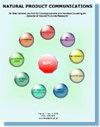通过氢键和 CH-π 相互作用实现碳水化合物的三明治式络合
IF 1.4
4区 医学
Q4 CHEMISTRY, MEDICINAL
引用次数: 0
摘要
导言:设计碳水化合物结合剂(人工碳水化合物受体),使其能够通过非共价相互作用进行选择性和有效的仿生物识别,其目的要么是为了更好地理解自然识别现象,要么是为了在医学和其他领域的各种潜在应用。尽管已经开发出了非常有趣的人工受体,但受体选择性的准确预测仍然是一个挑战。结果与方法:事实证明,基于 1,3,5-取代的 2,4,6-三乙基苯骨架的分子结构,带有两个基于氨基吡啶或氨基嘧啶的识别单元和一个嘌呤分子,该分子既是氢键位点,又是加入其他取代基的桥接成分,对于开发有效的碳水化合物结合剂非常有用。这类化合物能够通过组合非共价相互作用结合合适的碳水化合物,在碳水化合物底物的两个面上都能形成 CH---π 相互作用。利用微波辐照和密封管可以成功合成目标化合物。所进行的结合研究包括 1H NMR 光谱滴定和等温滴定量热法测量。结论:新化合物是作为人工受体开发的,特别适用于具有全赤道取代模式的碳水化合物,并能与合适的底物形成可预测的 1:1 强复合物。事实证明,利用嘌呤分子构建以 1,3,5 取代的 2,4,6 三乙基苯为骨架的碳水化合物受体是一种非常有前景的方法。这种分子结构变化的可能性是多方面的。因此,可以合成多种化合物,对结构和结合效率之间的关系进行广泛研究:新化合物作为人工受体被开发出来,尤其适用于具有全赤道取代模式的碳水化合物,并且能够与合适的底物形成可预测的 1:1 复合物。关键主题:人工碳水化合物受体;氢键与 CH۔۔۔π相互作用的结合;分子识别本文章由计算机程序翻译,如有差异,请以英文原文为准。
Sandwich-Like Complexation of Carbohydrates by Hydrogen Bonding and CH-π Interactions
Introduction: The design of carbohydrate-binding agents (artificial carbohydrate receptors) that enable selective and effective biomimetic recognition via noncovalent interactions is aimed either at a better understanding of natural recognition phenomena or at various potential applications in medicine and other fields. Although very interesting artificial receptors have been developed, the exact prediction of the receptor selectivity remains a challenge. Results and Methods: A molecular architecture based on a 1,3,5-substituted 2,4,6-triethylbenzene backbone bearing two aminopyridine- or aminopyrimidine-based recognition units and a purine moiety, which acts as both a hydrogen bonding site and a bridging component for the incorporation of additional substituents, has proved to be very useful for the development of effective carbohydrate-binding agents. This type of compounds has the ability to bind suitable carbohydrates through combined noncovalent interactions, where CH···π interactions can be formed on both faces of the carbohydrate substrate. The successful syntheses of the target compounds can be realized by the use of microwave irradiation and sealed tubes. The performed binding studies included 1 H NMR spectroscopic titrations and measurements by isothermal titration calorimetry. Conclusion: The new compounds were developed as artificial receptors especially for carbohydrates with an all-equatorial substitution pattern and have the ability to predictably form strong 1:1 complexes with a suitable substrate. The use of the purine moiety in the construction of carbohydrate receptors with a 1,3,5-substituted 2,4,6-triethylbenzene backbone has proved to be a very promising approach. The possibilities for structural variation of this molecular architecture are manifold. As a result, a wide range of compounds can be synthesized to perform extensive studies on the relationships between structure and binding efficiency.Graphical AbstractShort Text: New compounds were developed as artificial receptors especially for carbohydrates with an all-equatorial substitution pattern and have the ability to predictably form 1:1 complexes with a suitable substrate. Key Topics: Artificial carbohydrate receptors; Combination of hydrogen bonding and CH۔۔۔π interactions; Molecular recognition
求助全文
通过发布文献求助,成功后即可免费获取论文全文。
去求助
来源期刊

Natural Product Communications
工程技术-食品科技
CiteScore
3.10
自引率
11.10%
发文量
254
审稿时长
2.7 months
期刊介绍:
Natural Product Communications is a peer reviewed, open access journal studying all aspects of natural products, including isolation, characterization, spectroscopic properties, biological activities, synthesis, structure-activity, biotransformation, biosynthesis, tissue culture and fermentation. It covers the full breadth of chemistry, biochemistry, biotechnology, pharmacology, and chemical ecology of natural products.
Natural Product Communications is a peer reviewed, open access journal studying all aspects of natural products, including isolation, characterization, spectroscopic properties, biological activities, synthesis, structure-activity, biotransformation, biosynthesis, tissue culture and fermentation. It covers the full breadth of chemistry, biochemistry, biotechnology, pharmacology, and chemical ecology of natural products.
Natural Product Communications is a peer reviewed, open access journal studying all aspects of natural products, including isolation, characterization, spectroscopic properties, biological activities, synthesis, structure-activity, biotransformation, biosynthesis, tissue culture and fermentation. It covers the full breadth of chemistry, biochemistry, biotechnology, pharmacology, and chemical ecology of natural products.
 求助内容:
求助内容: 应助结果提醒方式:
应助结果提醒方式:


